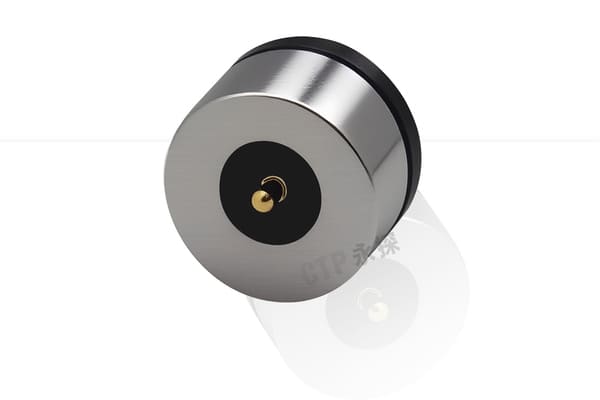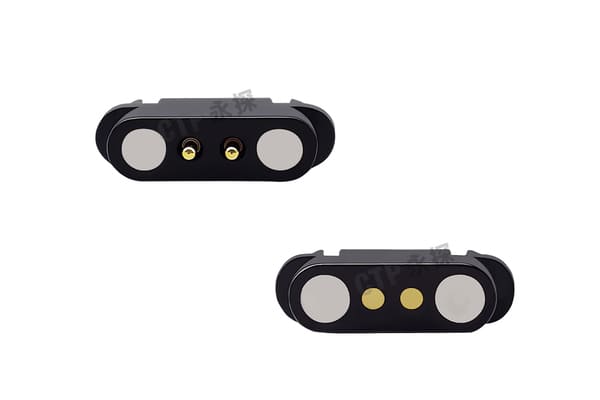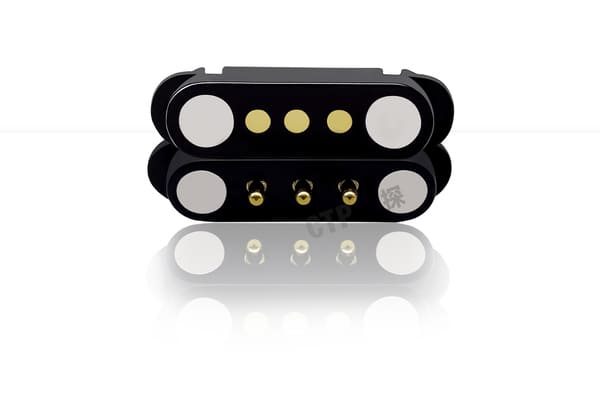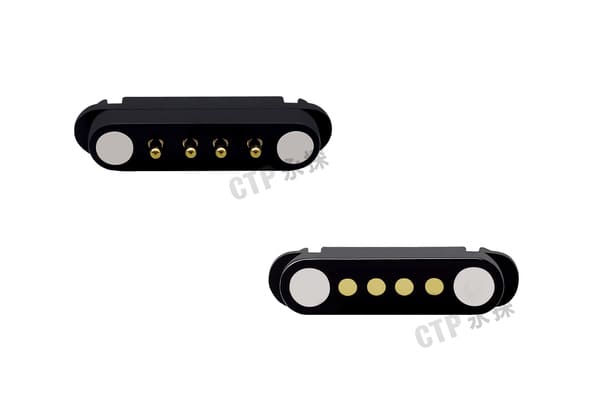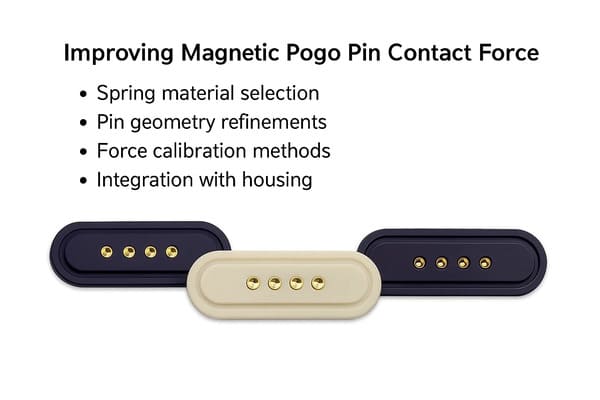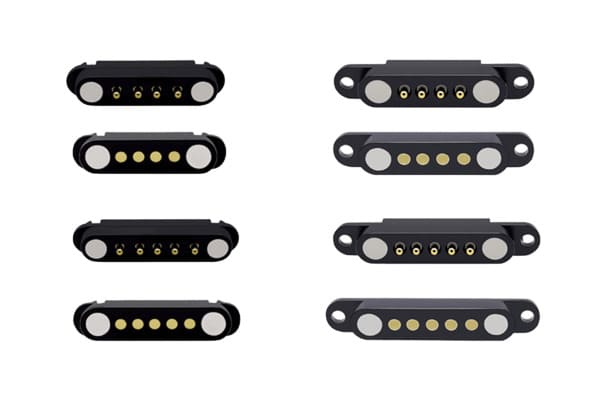Frustrated when your magnetic pogo pin connectors don’t hold firm or prove too tough to separate?
Engineers face this challenge often, resulting in unreliable devices.
It leads to user dissatisfaction and frequent returns. But there’s a way to fix it.
Magnetic pogo pin design optimizes performance by balancing magnetic force for secure alignment and contact force for stable electrical conductivity.
This balance is crucial because imbalances can lead to unreliable connections or excessive wear.
Optimizing these forces ensures consistent performance in critical applications and enhances durability.
Please continue reading to uncover how optimizing these forces in magnetic pogo pin design can elevate your product’s reliability and market edge.
Fundamentals of Magnetic Pogo Pins?
Imagine dealing with connectors that loosen under vibration or fail to transmit signals cleanly.
This common issue disrupts operations in critical applications.
A specialized magnetic pogo pin supplier can help by emphasizing core principles.
Magnetic pogo pins combine spring-loaded pins with integrated magnets, creating a reliable, self-aligning connection for power or data transfer.
The magnetic force ensures proper mating and a secure attachment, while the spring mechanism maintains consistent contact pressure for optimal electrical conductivity.
Key materials often include strong neodymium magnets and gold-plated plungers for durability.
These foundational elements set the stage for superior performance.
Let’s explore in detail why mastering them transforms your approach to magnetic pogo pin integration.
Magnetic Force Basics
Magnetic force drives the core functionality in magnetic pogo pin connectors, enabling secure and effortless connections.
Engineers prioritize this for stability in dynamic settings.
It underpins reliable retention without added mechanical latches.
- Defining magnetic force: This refers to the attractive pull between magnets in pogo pins, crucial for alignment and retention.
It ensures connectors snap together effortlessly, reducing misalignment risks in high-vibration environments like automotive applications.
Proper calibration prevents weak holds that lead to intermittent failures. - Role in connector stability: Magnetic force prevents disconnections under vibration or movement, vital in industrial settings.
It maintains a firm grip, minimizing drops in power or data transfer.
This stability is key to long-term reliability, avoiding issues like thermal degradation or magnet detachment. - Materials influencing magnetism: Neodymium or ferrite magnets are selected for varying strength needs.
Neodymium offers high pull for demanding applications, while ferrite suits cost-sensitive projects.
Choice depends on factors like temperature and resistance to avoid demagnetization. - Measurement techniques overview: Gauss meters quantify magnetic force for design validation.
These tools measure field strength accurately, ensuring specs meet application requirements.
Simulation software complements this by predicting optimizations before prototyping.
Mastering magnetic force basics enhances connector durability.
This knowledge leads naturally to understanding complementary contact mechanisms.
Contact Force Essentials
Contact force forms the backbone of magnetic pogo pin reliability, influencing everything from signal stability to longevity.
Engineers must balance it carefully to avoid common pitfalls.
This ensures robust performance across diverse industries.
- Understanding contact pressure: This mechanical force presses the pin against the pad, ensuring low electrical resistance for efficient conductivity.
It prevents signal distortion in high-frequency applications, with gold-plated contacts often achieving ≤20mΩ resistance.
Proper pressure supports stable power transfer without excessive wear. - Impact on signal integrity: Optimal contact reduces resistance, minimizing data errors and ensuring clean transmission.
In devices like wearables, it curbs failures from vibrations or misalignments.
This boosts overall system reliability, cutting downtime in industrial uses. - Spring mechanisms explained: Coil or leaf springs generate a consistent force, using materials like stainless steel for resilience.
They absorb shocks while maintaining pressure, ideal for dynamic environments.
Designs optimize compression for uniform contact over cycles. - Testing for reliability: Compression tests assess force durability across mating cycles, simulating real-world stress.
They measure parameters like deflection curves to validate performance.
This helps predict lifespan, addressing B2B concerns like quick delivery and customization.
Grasping these essentials unlocks better signal integrity.
Next, we’ll examine how they integrate with broader design strategies.
Optimization Strategies for Magnetic Pogo Pins?
Have you ever faced project delays due to connector redesigns?
Balancing forces poorly often causes this setback.
Innovative approaches can streamline your process.
Optimizing magnetic pogo pin connectors involves key strategies such as adjusting magnet sizes for ideal attractive force and refining spring materials and design for consistent contact pressure.
Utilizing simulations for accurate performance predictions also plays a crucial role.
These methods ensure balanced designs, addressing trade-offs in various applications like wearables.
Why does fine-tuning these matter?
It directly impacts efficiency and cost in procurement.
Enhancing Magnetic Force
Scaling magnet dimensions boosts strength without excess bulk in magnetic pogo pin designs.
This optimization is crucial for precision in compact devices.
It addresses environmental effects to maintain performance.
- Magnet size adjustments: Larger magnets increase pull force, but scaling must balance with space constraints.
For instance, a 1mm increase can enhance retention by 20%, ideal for high-density applications without adding weight. - Polarity configuration options: Multi-pole setups improve alignment precision in connectors.
They reduce misalignment risks, ensuring secure holds even in reversible cables like those for keyboards. - Environmental factor considerations: Temperature and humidity degrade magnetic performance over time.
Designs incorporating resistant materials mitigate this, preventing force loss in harsh conditions. - Simulation tools utilization: FEM software predicts magnetic field optimizations.
It allows virtual testing, cutting prototyping costs and time for custom OEM solutions.
These enhancements strengthen overall connector efficacy. They pave the way for complementary contact improvements.
Improving Contact Force
Evaluating spring materials like stainless steel ensures elasticity and resistance in magnetic pogo pins.
This refinement boosts longevity in demanding uses.
It integrates with housing for uniform pressure.
- Spring material selection: Stainless steel or beryllium copper offers corrosion resistance and durability.
Beryllium copper provides up to 50% IACS conductivity, supporting high-cycle applications without fatigue. - Pin geometry refinements: Tapered or rounded tips expand contact area, reducing wear.
This design minimizes resistance increases from oxidation, enhancing signal integrity over time. - Force calibration methods: Iterative testing sets ideal thresholds for specific applications.
Compression cycles assess consistency, ensuring forces stay within 10-60 grams for optimal performance. - Integration with housing: Enclosure designs support even contact distribution.
This prevents plunger sticking and maintains mechanical integrity in vibrations.
Improved contact force elevates reliability.
Now, consider how it balances with magnetic elements for peak performance.
Balancing Forces for Performance
Magnetic and contact forces complement each other in magnetic pogo pin connectors for overall efficacy.
Analyzing trade-offs aids in application-specific tailoring.
Rapid prototyping refines these balances.
- Interplay between forces: Magnetic attraction secures alignment, while contact pressure ensures conductivity.
Together, they prevent failures like intermittent connections under stress. - Design trade-offs analysis: Prioritizing magnetic force may bulk up designs, but contact emphasis risks weak holds.
Weighing pros and cons fits scenarios like high-vibration automotive use. - Customization for applications: Tailor forces for wearables, automotive, or medical devices.
For example, lower contact force suits delicate medical tools to avoid damage. - Prototyping best practices: Rapid iteration cycles fine-tune designs.
This reduces lead times, addressing B2B concerns like customization and quick sample delivery.
Balancing these forces optimizes ROI.
It transitions seamlessly to real-world applications.
Practical Applications and Benefits of Magnetic Pogo Pins?
Statistics show optimized connectors cut failure rates by up to 80% in emerging markets.
This highlights their value in diverse sectors.
A versatile magnetic pogo pin factory delivers tailored solutions here.
Magnetic pogo pins are widely used in consumer electronics for reliable charging and data transfer, such as in smartwatches and wireless earbuds.
They also feature in automotive electronics for in-car devices and navigation, benefiting from their shock and vibration resistance.
These durable connectors, with a spring structure supporting tens of thousands of cycles, also reduce assembly and maintenance costs.
These insights reveal tangible gains.
Delve into how they apply across industries for maximum impact.
Industry-Specific Use Cases
Magnetic pogo pins integrate across sectors, offering reliable connections in challenging environments.
This adaptability addresses B2B pain points like customization and delivery times.
It ensures performance in specialized applications.
- Consumer electronics integration: Used in smartphones and laptops for seamless charging.
They enable quick, reversible connections, reducing wear from frequent use. - Industrial automation examples: Applied in robotics for reliable data and power transfer.
Vibration-resistant designs maintain stability, minimizing downtime in automated systems. - Medical device adaptations: Featured in sterile, high-cycle connectors for diagnostic equipment.
They support accurate data transmission with minimal contamination risks. - Automotive sector implementations: Employed in vehicle infotainment for vibration-resistant designs.
This ensures consistent performance despite shocks and thermal cycles.
These use cases demonstrate versatility.
They lead to measurable improvements in metrics and returns.
Performance Metrics and ROI
Optimized force designs in magnetic pogo pins enhance cycle life, quantified by up to 5 million cycles with advanced materials.
This reduces long-term costs through lower failure rates.
Compliance with standards like ISO builds procurement confidence, while selecting experienced Chinese manufacturers ensures custom solutions.
- Durability enhancement metrics: Cycle life improves with balanced forces, reducing wear by 40%.
Metrics show extended lifespan in harsh environments, cutting replacement needs. - Cost reduction analysis: Lower failure rates save on maintenance and returns.
Lifecycle analysis indicates 30% savings over five years in automotive applications. - Quality assurance standards: IPC or ISO compliance ensures reliability.
This provides B2B buyers with certified products for regulated industries. - Supplier selection criteria: Evaluate for quick sample delivery and custom capabilities.
Focus on those offering one-stop solutions from prototyping to mass production.
These metrics underscore value.
They reinforce the importance of strategic design choices.
Conclusion
Balancing magnetic and contact forces in magnetic pogo pin design ensures reliable performance, reducing failures and costs in B2B applications.
This guide provides principles for optimization across industries.
For custom solutions, visit our homepage or contact page to connect with CTP’s expert team.

